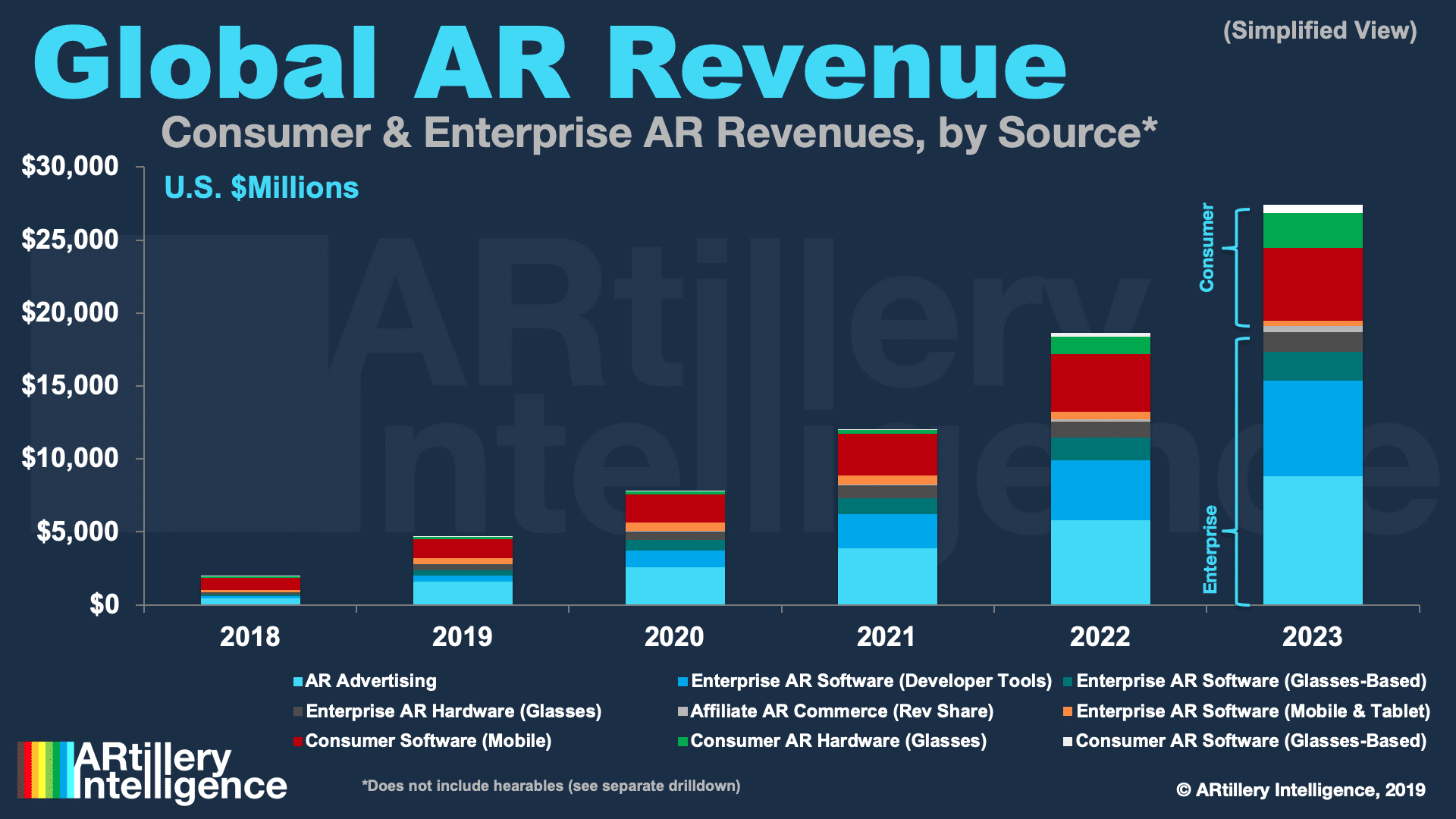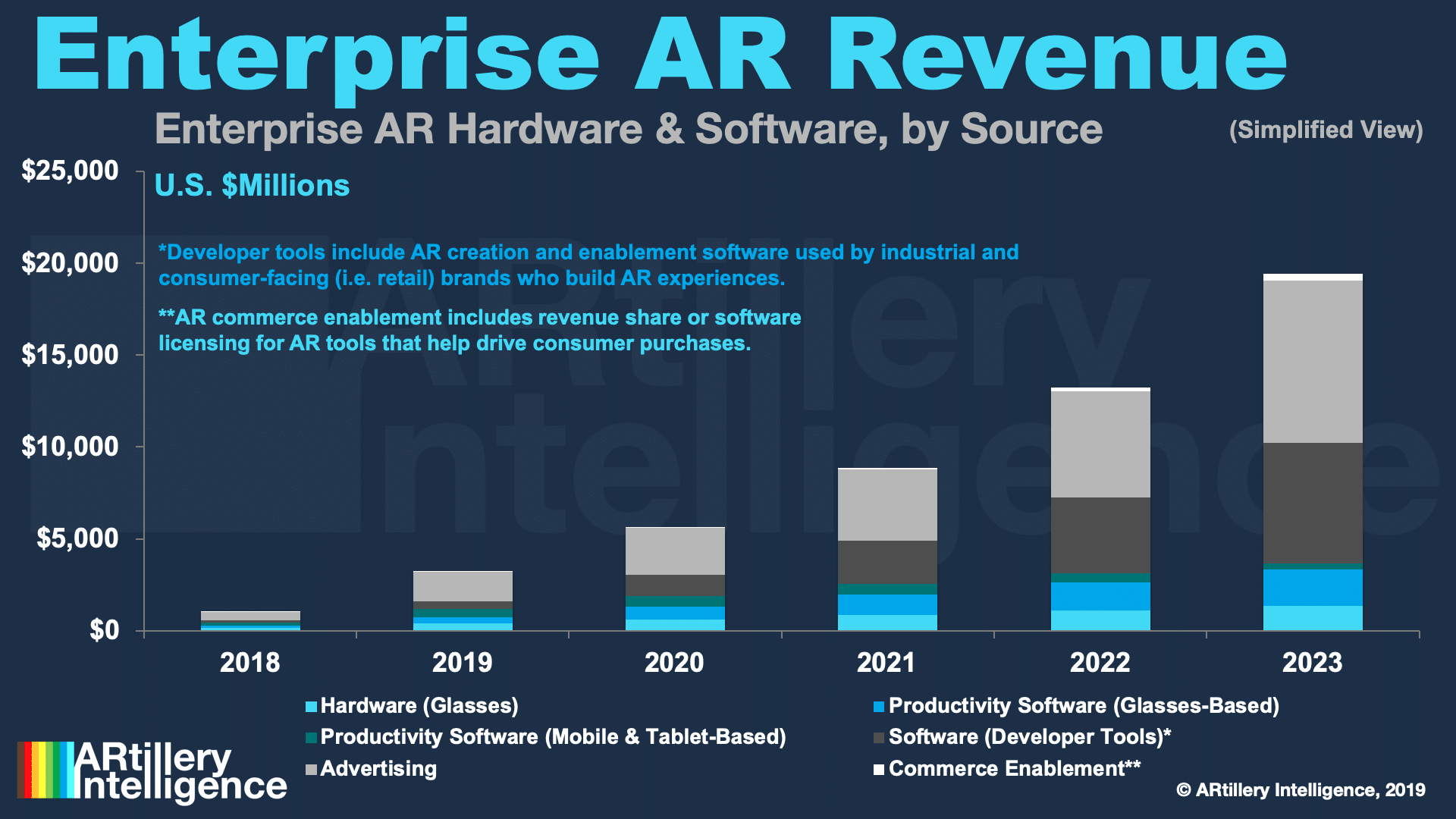
This post is adapted from ARtillery Intelligence’s report, Spatial Computing: 2019 Lessons, 2020 Outlook. It includes some of its data and takeaways. More can be previewed here and subscribe for the full report.
At this stage of spatial computing’s lifecycle, it’s becoming clear that patience is a virtue. After passing through the boom and bust cycle of 2016 and 2017, the last two years were more about measured optimism in the face of the sobering realities of industry shakeout and retraction.
At the precipice of 2020, that leaves the question of where we are now? Optimism is still present but AR and VR players continue to be tested as high-flying prospects like ODG, Meta and Daqri dissolve. These events are resetting expectations on the timing and scale of revenue outcomes.
But there are also confidence signals. 2019 was more of a “table-setting” year for our spatial future and there’s momentum building. Brand spending on sponsored mobile AR lenses is a bright spot, as is Apple AR glasses rumors. And Oculus Quest is a beacon of hope on the VR side.
To synthesize where we are and where we’re going, our research arm ARtillery Intelligence has published its annual year-end recap and year-forward outlook. This includes five predictions, listed below. Following our deep dive on #1, #2 and #3, today we’ll drill down on #4.
1. Apple Glasses Don’t Arrive in 2020
2. AR Wins With “Training Wheels”
3. Advertising Keeps the AR Revenue Crown
4. Industrial AR’s Inflection is Still One Year Away
5. VR Has an Evolutionary (not revolutionary) 2020

Prediction 4: Industrial AR Makes Incremental Gains
Industrial enterprise adoption of AR has been slower than industry proponents had hoped or predicted. This is due mostly to the common difficulties in implementing new technologies in large organizations. Regardless of the efficacy and ROI, there is inertia with any large paradigm shift.
This factor will continue in 2020, including the dreaded “pilot purgatory” that has been the biggest source of stalled implementations for industrial AR. Though the successful case studies get disproportionate attention, panning back to the larger market’s resistance is required for a full view.
There will be a tipping point for industrial AR, after which adoption accelerates in a sort of herd mentality. This is the common industry-adoption cycle, which can be seen in past paradigm shifts such as enterprise smartphone adoption. Industrial AR will be the same, but the question is when?

We believe the tipping point won’t come in 2020 but momentum will be gained so that it can come in 2021. 2020 will meanwhile see continued ROI proof points and case studies as companies like Lockheed Martin and Caterpillar continue to see and demonstrate real ROI gains.
Until that tipping point comes, Enterprise-targeted AR technologies will succeed in other areas outside of industrial and manufacturing-based implementations. For example, AR developer tools will be a leading source of enterprise AR spending, including authoring AR experiences.
The leading category of enterprise AR will in fact have a consumer endpoint. In other words, the area we track and define as “B2B2C” will outspend industrial AR by 2023. This includes software for AR experience creation for brands, retailers and other consumer-facing enterprises.

Boiling it Down
As for a concrete/quantifiable prediction for 2020, we believe that industrial AR spending will grow from $1.17 billion in 2019 to $1.88 billion in 2020. That includes hardware and software, such as AR glasses and visualization support for industrial assembly and maintenance.
Meanwhile, developer tools for AR creation will grow from $440 million in 2019 to $1.16 billion in 2020. This is just software, and goes beyond industrial users. An example of this is AR creation software such as Unity, and it includes spend/adoption by consumer-facing enterprises (B2B2C).
Of course all of the above is speculative and based on market signals we’re tracking closely. It will be a moving target, and we’ll course correct as market factors unfold. We’ll also hold ourselves to task in 2020 for all predictions. Stay tuned for more and see the full report here.
For deeper XR data and intelligence, join ARtillery PRO and subscribe to the free AR Insider Weekly newsletter.
Disclosure: AR Insider has no financial stake in the companies mentioned in this post, nor received payment for its production. Disclosure and ethics policy can be seen here.
